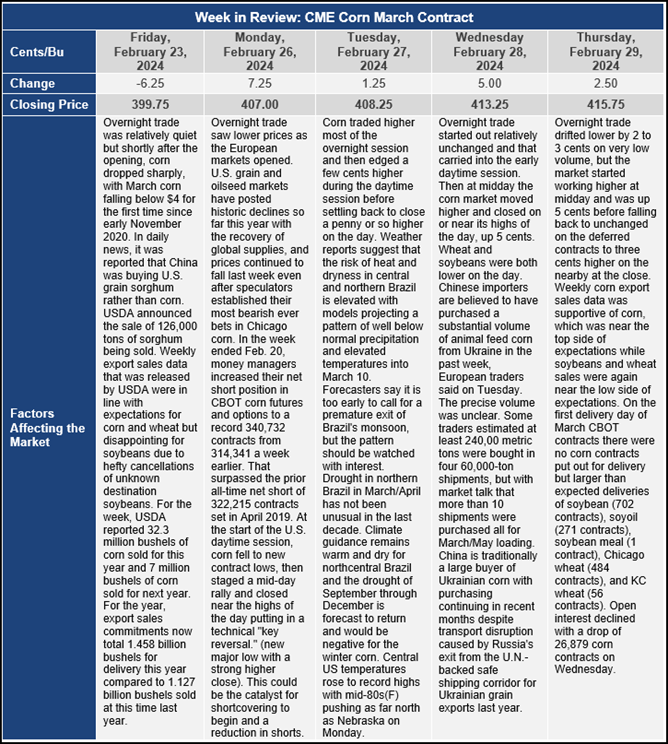Chicago Board of Trade Market News

Outlook
It appears that the corn market may have run out of sellers, at least in the near-term, and thus sideways to upper movement may be seen as the record large short positions are covered. This will be a welcome change for farmers in the U.S. as they are getting ready to put the 2024 corn crop in the ground. With near record warm temperatures being seen in many areas from Texas to the northern parts of the Cornbelt, corn planters have begun running in southern U.S. states. In Iowa, preparatory fieldwork such as fertilizer application has begun. These usually do not begin until the second or third week of March but record warm temperatures in the last half of February have allowed early field work to begin.
The macro-economic setting in the U.S. produced mixed news this week. Fourth quarter 2023 GDP was revised slightly lower from the initial report to 3.2% growth, down from the initial report of 3.3%. At the same time, consumer spending was revised up from 2.8% to 3%, services were revised up from 2.4% to 2.8% but goods were revised down from 3.8% to 3.2%. Government spending was revised up from 3.3% to 4.2%. The higher level of government spending widened the gap between growth in government debt and economic growth. In total, the U.S. economy grew by $335 billion in the 4th quarter, while federal debt expanded by $834 billion. U.S. federal debt now stands at 122% of GDP, and the only time that ratio has been higher was in the midst of the COVID-19 pandemic from Q3 2020 through Q1 2021.
A very brief, two-day cold snap hit the U.S. Plains states and the western Cornbelt states. Low temperatures were recorded Thursday morning in the teens and single digits as far south as the Texas-Oklahoma panhandles and as far east as Illinois. The primary concern this time of year is centered on wheat which had resumed growth in many areas of the southern Plains. It will be several days before an assessment of damage can be determined. Longer-term, a warmer than normal spring season and early planting season is probable. Dryness in the Plains and active rainfall in the southeastern U.S. is a rather normal seasonal occurrence in late February-early March but the areas of extreme dryness are already expanding in parts of the Plains and into the western Cornbelt. Warm-dry winds are sucking the moisture out of the topsoil.
China’s corn market is not behaving like one that just experienced record production and stocks building. USDA pegged final Chinese corn production at 288 MMTs, up 12 MMTs compared to 2022. Yield was a record 104 bushels per acre. In the face of this, China’s October to February imports are estimated to be 18.8 MMTs, a record and double last year’s pace. Chinese corn imports must drop off dramatically from here forward if USDA’s annual forecast of 23 MMTs is correct. While much of China’s current demand is being supplied by Brazil and Ukraine, it seems that China is likely to import 26-28 MMTs in crop year 2023/24, 10 to 20 percent more than USDA’s current forecast.
China has also been active in securing U.S. sorghum for its feed market. Chinese sorghum imports are a solid proxy for real Chinese feed demand since there is no need to acquire TRQ licenses for sorghum imports. Based on the ship lineup, mostly from the U.S., October-March sorghum imports are projected to reach 3.9 MMTs versus 1.7 MMTs a year ago. Total U.S. sorghum export commitments of Feb 15th totaled 173 million bushels (54% of USDA’s annual forecast) versus just 39 million bushels last year.
